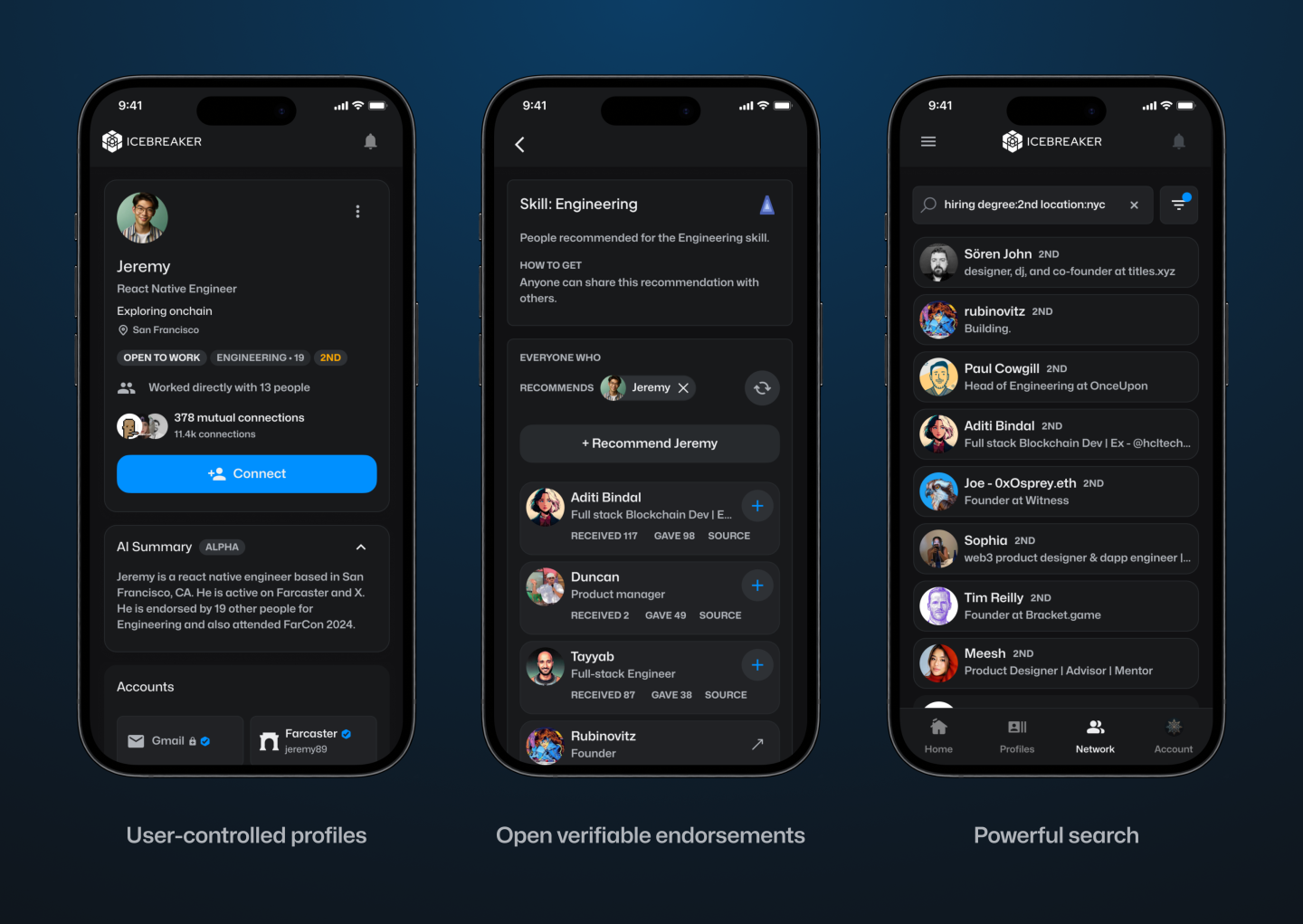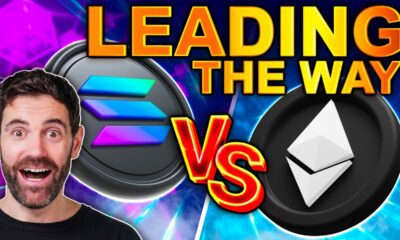News
How Blockchain Is Getting Safer and Faster

THE Cardano Foundation has been working on a building block that introduces inter-blockchain communication (IBC) protocol capabilities to the Cardano blockchain, specifically designed to enable trustless transactions and data exchanges between distinct blockchain networks.
In recent months, Composable Finance has launched the first IBC implementation that connects Pois and Kusama, and connections are being developed with Avalanche via Landslide, NEAR via Omnity Network, BNB via Toki, Polygon via Union and now Ethereum and Solana via Picasso Network.
The IBC framework not only works to improve existing systems, but also to expand what they can accomplish. It facilitates the transfer of data and assets between different blockchains, while still ensuring that businesses benefit from the security and deterministic fees inherent to the Cardano blockchain.
For these reasons, The Cryptonomist decided to conduct an interview with Susannah Evans, IBC Product Lead at the Interchain Foundation and Sebastian Bode, VP of Engineering at the Cardano Foundation.
Can you explain how IBC facilitates interoperability between different blockchain networks and what specific challenges it faces in the current blockchain ecosystem?
Susannah: Interoperability is often seen as an application through smart contracts and not directly part of the core blockchain protocols. IBC was designed to enable communication between different blockchain networks for a more seamless development of decentralized networks, leveraging this as a core function of blockchain. For this to work, the protocol must be viable, credible, and accessible. We have seen other ecosystems struggle with trust, those that do not integrate interoperability as a primary initiative for the blockchain ecosystem. IBC is designed to address these core issues: it has been battle-tested to enable both cross-chain and token bridging, trusting the consensus of the chains involved without the need for third-party verification.
Sebastian: From Cardano’s perspective, how does integrating or collaborating with IBC enhance Cardano’s capabilities and user experience?
Businesses that rely on Cardano can now create their own application-specific blockchains. This gives them more flexibility in terms of privacy and scalability, while still having the strong security and reliability of the Cardano blockchain. For end users, they have access to more diverse Dapps, while also opening up the DeFi and asset trading space between both ecosystems so liquidity can flow more easily.
What are the key technical aspects of IBC that ensure secure and efficient cross-chain communication?
Susannah: IBC facilitates the secure and permissionless transfer of different data between blockchains. The protocol is designed to be consensus agnostic, meaning it can run on different consensus mechanisms used by different blockchains. This flexibility allows IBC to facilitate communication between different blockchain networks without requiring significant changes to their core protocols. Its lightweight client-based approach eliminates the need for a trusted third party in cross-chain interactions, safeguarding significant annual transfers of value without any exploits since its inception. IBC also employs a relayer model where independent, permissionless relayers are responsible for transferring data packets between blockchains, meaning the data cannot be altered or tampered with, as their role is purely to facilitate seamless communication.
Could you provide information on the technical changes or developments that Cardano has made to integrate with IBC and what benefits this brings to Cardano developers and end users?
Sebastian: Cardano hasn’t had to make any changes at the core level, as we rely solely on our Aiken smart contract platform. Other existing development tools come mainly from the Go and Typescript language ecosystem, as well as Mithril, a product developed by IOHK to bring threshold-based signatures and these state-proof primitives to Cardano. This primarily brings another building block for developers and businesses building on Cardano and gives them a larger solution space for challenges. It also opens up the possibility of adding additional EVM compatibility options to Cardano via a sidechain.
Can you highlight some successful use cases or applications that have leveraged IBC for cross-chain functionality?
Susannah: This year, IBC turned 3 years old, making it the oldest and most widely used interoperability protocol, a significant milestone for our team and a time to reflect on our success over the past 3 years. The recent integration of Cardano has expanded our goal of promoting greater interoperability and showcasing the importance of interoperability in blockchain ecosystems. In addition to the Cosmos SDK chains, IBC has seamlessly integrated with Polkadot, Bitcoinand Solana ecosystems, expanding networks in line with the goal of optimal interoperability. For example, IBC’s connection to the Solana ecosystem, known for its high-speed, low-cost transaction approach, facilitates the secure transfer of assets between multiple ecosystems and allows developers and users to access a range of capabilities from both ecosystems. These partnerships have expanded IBC’s reach and demonstrated its ability to diversify and redefine true cross-chain capabilities.
How does Cardano intend to leverage these cross-chain capabilities to expand its ecosystem and support innovative projects?
Sebastian: The Cardano FoundationThe initiative primarily aims to demonstrate the viability of cross-chain interoperability using a widely adopted protocol such as IBC. This approach serves two purposes: first, it mitigates the risks that community members would otherwise face when exploring the viability of such an approach. Second, it inspires ecosystem projects to develop DApps that can leverage Cardano’s robust public infrastructure while simultaneously interacting with the broader interchain network. These DApps can also benefit from the flexibility offered by application-specific sidechains.
What are the next developments or improvements planned for IBC and how will they impact the broader blockchain landscape?
Susannah: We are working on integrations with many other ecosystems, some publicly announced, such as IBC’s integration with Toki Finance to connect BSC, and others yet to be announced. As more blockchains embrace IBC as a trusted consensus mechanism for interoperability, more ecosystems will be drawn to expand with us. We are grateful to the Cardano team for their contributions and initiative to expand with us and our community. More integrations like these allow our network to mature as various blockchain architectures advance IBC’s offerings.
What are Cardano’s future plans in terms of improving interoperability with other blockchains and how does IBC fit into this strategy?
Sebastian: IBC is just one of many building blocks that are coming to Cardano to improve interoperability. There are several other activities currently underway and others that have already been completed. For example, there is a community project called UniFires that is working closely with the Polkadot ecosystem to bring interoperability between Cardano and Polkadot. Additionally, the VISTA group is working on building an entire interoperability landscape on Cardano to push enterprise adoption to the forefront of existing assets and bridges like WANChain, EVM Sidechains like Milkomeda, and others. IOHK is also pushing hard in this direction with their groundbreaking research on multi-asset consensus and the partnerchains framework.
How does IBC engage with the broader blockchain community to promote and foster adoption of its protocol?
Susannah: IBC is constantly striving for new connections and integrations. We have formed a series of strategic partnerships since IBC’s inception with leading blockchain projects and platforms. With the concept of interoperability at the core of IBC, it was developed as an open-source protocol, inviting developers from around the world to contribute to its improvement and expansion. The open-source approach fosters a collaborative environment where ideas and innovations can be freely exchanged, accelerating the development of robust interoperability solutions. By integrating with major networks, IBC not only showcases its broad technological capabilities, but also leverages multiple blockchain user bases and developer communities from industry-leading projects to drive broader blockchain adoption.
How does the Cardano Foundation collaborate with IBC and other interoperability solutions to foster a more connected and collaborative blockchain ecosystem?
Sebastian: First of all, we are trying to be as transparent as possible, which is why the technical solution has already been made public. On the other hand, we have already received enormous support from organizations such as the Interchain Foundation and projects in the Cosmos ecosystem. Finally, the exceptionally talented developers and the SPO community within Cardano are supporting us with their expertise.
Security is key in blockchain communication. How does IBC ensure the integrity and security of transactions between different chains?
Susannah: To achieve seamless interoperability, developers and users need to be able to leverage the strengths of different blockchains without compromising security or performance. IBC’s security model relies on trust in the consensus of the chains that want to communicate through the use of light clients. Light clients have a first-time trust security model and use inclusion and exclusion proofs to verify whether or not a transaction has taken place on the other chain.
In addition to lightweight clients, the protocol has been formally verified, has undergone third-party review, and implements security practices such as defense-in-depth within the codebase. These features demonstrate the integrity of transactions, reducing the risk of vulnerabilities and ensuring strong security guarantees for other blockchains. Considering these meticulously tested features, IBC achieves a high level of security and efficiency in cross-chain communication, addressing many of the security challenges faced by blockchain ecosystems.
How does Cardano’s governance model support the integration of interoperability solutions such as IBC and what measures are taken to manage potential security risks?
Sebastian: In terms of governance, it is necessary to assess the impacts of parameter changes. The right approach here is to educate users and provide tools that help decentralized governance participants better understand the consequences of their votes.
On the security side, we are currently going through a multi-stage audit process. When it comes to operating a bridge to the broader Cosmos ecosystem, we are partnering with entities that have extensive experience in bridge operations. These partners are able to properly monitor and, in the event of any disaster, implement mitigation strategies or countermeasures.
News
Terra Can’t Catch a Break as Blockchain Gets $6 Million Exploited

The attack, which exploited a vulnerability disclosed in April, drained around 60 million ASTRO tokens, sending the price plummeting.
The Terra blockchain has been exploited for over $6 million, forcing developers to take a momentary break the chain.
Beosin Cyber Security Company reported that the protocol lost 60 million ASTRO tokens, 3.5 million USDC, 500,000 USDT, and 2.7 BTC or $180,000.
Terra developers paused the chain on Wednesday morning to apply an emergency patch that would address the attack. Moments later, a 67% majority of validators upgraded their nodes and resumed block production.
The ASTRO token has plunged as much as 75%. It is now trading at $0.03, a 25% decline on the day. Traders who took advantage of the drop are now on 195%.
The vulnerability that took down the Cosmos-based blockchain was disclosed in April and involved the deployment of a malicious CosmWasm contract. It opened the door to attacks via what is called an “ibc-hooks callback timeout reentrancy vulnerability,” which is used to invoke contracts and enable cross-chain swaps.
Terra 2.0 also suffered a massive drop in total value locked (TVL) in April, shortly after the vulnerability was discovered. It plunged 80% to $6 million from $30 million in TVL and has since lost nearly half of that value, currently sitting at $3.9 million.
The current Earth chain emerged from the rubble as a hard fork after the original blockchain, now called Terra Classic, collapsed in 2022. Terra collapsed after its algorithmic stablecoin (UST) lost its peg, causing a run on deposits. More than $50 billion of UST’s market cap was wiped out in a matter of days.
Terraform Labs, the company behind the blockchain, has been slowly unravelling its legal woes since its mid-2022 crash. Founder Do Kwon awaits sentencing in Montenegro after he and his company were found liable for $40 billion in customer funds in early April.
On June 12, Terraform Labs settled with the SEC for $4.4 billion, for which the company will pay about $3.59 billion plus interest and a $420 million penalty. Meanwhile, Kwon will pay $204.3 million, including $110 million in restitution, interest and an $80 million penalty, a court filing showed.
News
Google and Coinbase Veterans Raise $5M to Build Icebreaker, Blockchain’s Answer to LinkedIn

Icebreaker: Think LinkedIn but on a Blockchain—announced Wednesday that it has secured $5 million in seed funding. CoinFund led the round, with participation from Accomplice, Anagram, and Legion Capital, among others.
The company, which is valued at $21 million, aims to become the world’s first open-source network for professional connections. Its co-founders, Dan Stone and Jack Dillé, come from Google AND Monetary base; Stone was a product manager at the cryptocurrency giant and also the co-creator of Google’s largest multi-identity measurement and marketing platform, while Dillé was a design manager for Google Working area.

The pair founded Icebreaker on the shared belief that the imprint of one’s digital identity (and reputation) should not be owned by a single entity, but rather publicly owned and accessible to all. Frustrated that platforms like LinkedIn To limit how we leverage our connections, Dillé told Fortune he hopes to remove paywalls and credits, which “force us to pay just to browse our network.” Using blockchain technology, Icebreaker lets users transfer their existing professional profile and network into a single, verified channel.
“Imagine clicking the login button and then seeing your entire network on LinkedIn, ChirpingFarcaster and email? Imagine how many introductions could be routed more effectively if you could see the full picture of how you’re connected to someone,” Stone told Fortune.
Users can instantly prove their credentials and provide verifiable endorsements for people in their network. The idea is to create an “open graph of reputation and identity,” according to the founders. They hope to challenge LinkedIn’s closed network that “secures data,” freeing users to search for candidates and opportunities wherever they are online. By building on-chain, the founders note, they will create a public ledger of shared context and trust.
Verified channels are now launched for
Chirping
Online Guide
Wallet
Discord
Telephone
TeleporterYou can find them in Account -> Linked Accounts Italian: https://t.co/mRDyuWW8O2
— Icebreaker (@icebreaker_xyz) April 3, 2024
“Digital networking is increasingly saturated with noise and AI-driven fake personas,” the founders said in a statement. For example: Dillé’s LinkedIn headline reads “CEO of Google,” a small piece of digital performance art to draw attention to unverifiable information on Web2 social networks that can leave both candidates and recruiters vulnerable to false claims.
“Icebreaker was created to enable professionals to seamlessly tap into their existing profiles and networks to surface exceptional people and opportunities, using recent advances in cryptographically verifiable identity,” the company said, adding that the new funding will go towards expanding its team and developing products.
“One of the next significant use cases for cryptocurrency is the development of fundamental social graphs for applications to leverage… We are proud to support Dan, Jack and their team in their mission to bring true professional identity ownership to everyone online,” said CoinFund CIO Alex Felix in a statement.
Learn more about all things cryptocurrency with short, easy-to-read flashcards. Click here to Fortune’s Crash Course in Cryptocurrency.
Fuente
News
Luxembourg proposes updates to blockchain laws | Insights and resources

On July 24, 2024, the Ministry of Finance proposed Blockchain Bill IVwhich will provide greater flexibility and legal certainty for issuers using Distributed Ledger Technology (DLT). The bill will update three of Luxembourg’s financial laws, the Law of 6 April 2013 on dematerialised securitiesTHE Law of 5 April 1993 on the financial sector and the Law of 23 December 1998 establishing a financial sector supervisory commissionThis bill includes the additional option of a supervisory agent role and the inclusion of equity securities in dematerialized form.
DLT and Luxembourg
DLT is increasingly used in the financial and fund management sector in Luxembourg, offering numerous benefits and transforming various aspects of the industry.
Here are some examples:
- Digital Bonds: Luxembourg has seen multiple digital bond issuances via DLT. For example, the European Investment Bank has issued bonds that are registered, transferred and stored via DLT processes. These bonds are governed by Luxembourg law and registered on proprietary DLT platforms.
- Fund Administration: DLT can streamline fund administration processes, offering new opportunities and efficiencies for intermediaries, and can do the following:
- Automate capital calls and distributions using smart contracts,
- Simplify audits and ensure reporting accuracy through transparent and immutable transaction records.
- Warranty Management: Luxembourg-based DLT platforms allow clients to swap ownership of baskets of securities between different collateral pools at precise times.
- Tokenization: DLT is used to tokenize various assets, including real estate and luxury goods, by representing them in a tokenized and fractionalized format on the blockchain. This process can improve the liquidity and accessibility of traditionally illiquid assets.
- Tokenization of investment funds: DLT is being explored for the tokenization of investment funds, which can streamline the supply chain, reduce costs, and enable faster transactions. DLT can automate various elements of the supply chain, reducing the need for reconciliations between entities such as custodians, administrators, and investment managers.
- Issuance, settlement and payment platforms:Market participants are developing trusted networks using DLT technology to serve as a single source of shared truth among participants in financial instrument investment ecosystems.
- Legal framework: Luxembourg has adapted its legal framework to accommodate DLT, recognising the validity and enforceability of DLT-based financial instruments. This includes the following:
- Allow the use of DLT for the issuance of dematerialized securities,
- Recognize DLT for the circulation of securities,
- Enabling financial collateral arrangements on DLT financial instruments.
- Regulatory compliance: DLT can improve transparency in fund share ownership and regulatory compliance, providing fund managers with new opportunities for liquidity management and operational efficiency.
- Financial inclusion: By leveraging DLT, Luxembourg aims to promote greater financial inclusion and participation, potentially creating a more diverse and resilient financial system.
- Governance and ethics:The implementation of DLT can promote higher standards of governance and ethics, contributing to a more sustainable and responsible financial sector.
Luxembourg’s approach to DLT in finance and fund management is characterised by a principle of technology neutrality, recognising that innovative processes and technologies can contribute to improving financial services. This is exemplified by its commitment to creating a compatible legal and regulatory framework.
Short story
Luxembourg has already enacted three major blockchain-related laws, often referred to as Blockchain I, II and III.
Blockchain Law I (2019): This law, passed on March 1, 2019, was one of the first in the EU to recognize blockchain as equivalent to traditional transactions. It allowed the use of DLT for account registration, transfer, and materialization of securities.
Blockchain Law II (2021): Enacted on 22 January 2021, this law strengthened the Luxembourg legal framework on dematerialised securities. It recognised the possibility of using secure electronic registration mechanisms to issue such securities and expanded access for all credit institutions and investment firms.
Blockchain Act III (2023): Also known as Bill 8055, this is the most recent law in the blockchain field and was passed on March 14, 2023. This law has integrated the Luxembourg DLT framework in the following way:
- Update of the Act of 5 August 2005 on provisions relating to financial collateral to enable the use of electronic DLT as collateral on financial instruments registered in securities accounts,
- Implementation of EU Regulation 2022/858 on a pilot scheme for DLT-based market infrastructures (DLT Pilot Regulation),
- Redefining the notion of financial instruments in Law of 5 April 1993 on the financial sector and the Law of 30 May 2018 on financial instruments markets to align with the corresponding European regulations, including MiFID.
The Blockchain III Act strengthened the collateral rules for digital assets and aimed to increase legal certainty by allowing securities accounts on DLT to be pledged, while maintaining the efficient system of the 2005 Act on Financial Collateral Arrangements.
With the Blockchain IV bill, Luxembourg will build on the foundations laid by previous Blockchain laws and aims to consolidate Luxembourg’s position as a leading hub for financial innovation in Europe.
Blockchain Bill IV
The key provisions of the Blockchain IV bill include the following:
- Expanded scope: The bill expands the Luxembourg DLT legal framework to include equity securities in addition to debt securities. This expansion will allow the fund industry and transfer agents to use DLT to manage registers of shares and units, as well as to process fund shares.
- New role of the control agent: The bill introduces the role of a control agent as an alternative to the central account custodian for the issuance of dematerialised securities via DLT. This control agent can be an EU investment firm or a credit institution chosen by the issuer. This new role does not replace the current central account custodian, but, like all other roles, it must be notified to the Commission de Surveillance du Secteur Financier (CSSF), which is designated as the competent supervisory authority. The notification must be submitted two months after the control agent starts its activities.
- Responsibilities of the control agent: The control agent will manage the securities issuance account, verify the consistency between the securities issued and those registered on the DLT network, and supervise the chain of custody of the securities at the account holder and investor level.
- Simplified payment processesThe bill allows issuers to meet payment obligations under securities (such as interest, dividends or repayments) as soon as they have paid the relevant amounts to the paying agent, settlement agent or central account custodian.
- Simplified issuance and reconciliationThe bill simplifies the process of issuing, holding and reconciling dematerialized securities through DLT, eliminating the need for a central custodian to have a second level of custody and allowing securities to be credited directly to the accounts of investors or their delegates.
- Smart Contract Integration:The new processes can be executed using smart contracts with the assistance of the control agent, potentially increasing efficiency and reducing intermediation.
These changes are expected to bring several benefits to the Luxembourg financial sector, including:
- Fund Operations: Greater efficiency and reduced costs by leveraging DLT for the issuance and transfer of fund shares.
- Financial transactions: Greater transparency and security.
- Transparency of the regulatory environment: Increased attractiveness and competitiveness of the Luxembourg financial centre through greater legal clarity and flexibility for issuers and investors using DLT.
- Smart Contracts: Potential for automation of contractual terms, reduction of intermediaries and improvement of transaction traceability through smart contracts.
Blockchain Bill IV is part of Luxembourg’s ongoing strategy to develop a strong digital ecosystem as part of its economy and maintain its status as a leading hub for financial innovation. Luxembourg is positioning itself at the forefront of Europe’s growing digital financial landscape by constantly updating its regulatory framework.
Local regulations, such as Luxembourg law, complement European regulations by providing a more specific legal framework, adapted to local specificities. These local laws, together with European initiatives, aim to improve both the use and the security of projects involving new technologies. They help establish clear standards and promote consumer trust, while promoting innovation and ensuring better protection against potential risks associated with these emerging technologies. Check out our latest posts on these topics and, for more information on this law, blockchain technology and the tokenization mechanism, do not hesitate to contact us.
We are available to discuss any project related to digital finance, cryptocurrencies and disruptive technologies.
This informational piece, which may be considered advertising under the ethics rules of some jurisdictions, is provided with the understanding that it does not constitute the rendering of legal or other professional advice by Goodwin or its attorneys. Past results do not guarantee a similar outcome.
News
New bill pushes Department of Veterans Affairs to examine how blockchain can improve its work

The Department of Veterans Affairs would have to evaluate how blockchain technology could be used to improve benefits and services offered to veterans, according to a legislative proposal introduced Tuesday.
The bill, sponsored by Rep. Nancy Mace, R-S.C., would direct the VA to “conduct a comprehensive study of the feasibility, potential benefits, and risks associated with using distributed ledger technology in various programs and services.”
Distributed ledger technology, including blockchain, is used to protect and track information by storing data across multiple computers and keeping a record of its use.
According to the text of the legislation, which Mace’s office shared exclusively with Nextgov/FCW ahead of its publication, blockchain “could significantly improve benefits allocation, insurance program management, and recordkeeping within the Department of Veterans Affairs.”
“We need to bring the federal government into the 21st century,” Mace said in a statement. “This bill will open the door to research on improving outdated systems that fail our veterans because we owe it to them to use every tool at our disposal to improve their lives.”
Within one year of the law taking effect, the Department of Veterans Affairs will be required to submit a report to the House and Senate Veterans Affairs committees detailing its findings, as well as the benefits and risks identified in using the technology.
The mandatory review is expected to include information on how the department’s use of blockchain could improve the way benefits decisions are administered, improve the management and security of veterans’ personal data, streamline the insurance claims process, and “increase transparency and accountability in service delivery.”
The Department of Veterans Affairs has been studying the potential benefits of using distributed ledger technology, with the department emission a request for information in November 2021 seeking input from contractors on how blockchain could be leveraged, in part, to streamline its supply chains and “secure data sharing between institutions.”
The VA’s National Institute of Artificial Intelligence has also valued the use of blockchain, with three of the use cases tested during the 2021 AI tech sprint focused on examining its capabilities.
Mace previously introduced a May bill that would direct Customs and Border Protection to create a public blockchain platform to store and share data collected at U.S. borders.
Lawmakers also proposed additional measures that would push the Department of Veterans Affairs to consider adopting other modernized technologies to improve veteran services.
Rep. David Valadao, R-Calif., introduced legislation in June that would have directed the department to report to lawmakers on how it plans to expand the use of “certain automation tools” to process veterans’ claims. The House of Representatives Subcommittee on Disability Assistance and Memorial Affairs gave a favorable hearing on the congressman’s bill during a Markup of July 23.
-

 Videos9 months ago
Videos9 months agoCrypto News: Bitcoin, ETH Price, CPI Print, PYTH, WIF & MORE!!
-

 Videos9 months ago
Videos9 months agoCrypto News: Bitcoin Price, ETF, ETH, WIF, HNT & MORE!!
-

 DeFi9 months ago
DeFi9 months agoMetasphere Labs announces follow-up event regarding
-

 Videos9 months ago
Videos9 months agoSolana price potential?! Check out THIS update if you own SOL!!
-

 Videos8 months ago
Videos8 months agoWho Really CONTROLS THE MARKETS!! Her plans REVEALED!!
-

 DeFi6 months ago
DeFi6 months agoPump.Fun Overtakes Ethereum in Daily Revenue: A New Leader in DeFi
-

 News6 months ago
News6 months agoNew bill pushes Department of Veterans Affairs to examine how blockchain can improve its work
-

 DeFi6 months ago
DeFi6 months agoDegens Can Now Create Memecoins From Tweets
-

 News6 months ago
News6 months agoLawmakers, regulators to study impact of blockchain and cryptocurrency in Alabama • Alabama Reflector
-

 Bitcoin6 months ago
Bitcoin6 months ago1 Top Cryptocurrency That Could Surge Over 4,300%, According to This Wall Street Firm
-

 Ethereum8 months ago
Ethereum8 months agoComment deux frères auraient dérobé 25 millions de dollars lors d’un braquage d’Ethereum de 12 secondes • The Register
-

 Videos8 months ago
Videos8 months agoCryptocurrency News: BTC Rally, ETH, SOL, FTM, USDT Recover & MORE!













 ASTRO Price
ASTRO Price


